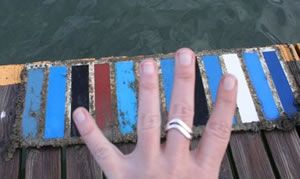
I just finished a quick run-through on bottom paint prices and noticed that, for the first time in recent memory, I don’t see any significant price jumps. Naturally, with the lagging economy, it behooves paint makers to offer the best value to consumers. Nevertheless, I was surprised by some of the prices, particularly since copper prices have regained much of the ground they lost last year. Several of our Good paints in our six-month checkup fell right around $100/gallon mark.
The above photo shows what this years crop of six-month paints look like after they were sluiced once with a 5-gallon bucket of saltwater. You’ll see that most of the slime had easily rinsed away. It is likely that using your boat will have the same effect, washing away most of the slime growth. Almost all of the growth that remained on these six-month panels could be easily wiped away with a sponge. My recent post showed a photo of them prior to being sluiced.
The above photo also shows the simple method we use to record data for our files, allowing us to keep track of more than 200 paints in three different locations. Each panel is identified by a unique number of holes drilled in it. The number of holes coincides with numbers on an Excel table that is filed when each panel is painted. Judges are given a copy of the same table, with only the coded number for the panel and the color of the paints in sequence. On the six-month panels, the holes, just like almost every unpainted surface, were clogged with barnacles. Testers actually had to punch through the growth with a screwdriver, just to confirm the panel identification.
If you look on the top left-hand corner of the panel in the photograph, youll see four holes, indicating that this is Panel 4. After the panels are rated, the ratings taken at the test site-Poor, Fair, Good, Excellent-are matched up with the paints identified on the master Excel table.
For the curious, thats Managing Editor Ann Keys hand in the photograph – not mine. The last time I wore a ring (an expensive wedding band), it wound up at the bottom of Narragansett Bay while I was reefing a sail on a friends Vineyard Vixen. Also, my nails usually look much grimier.








































